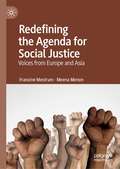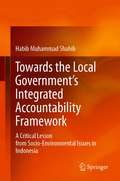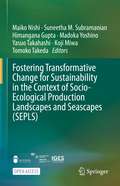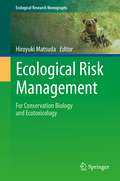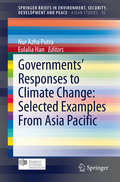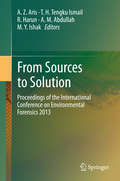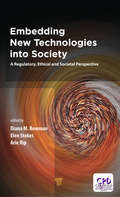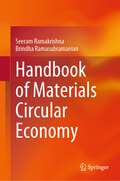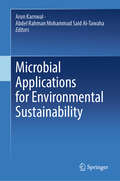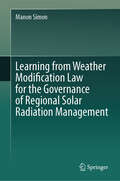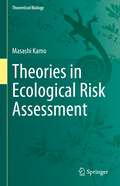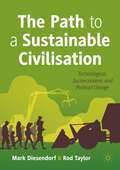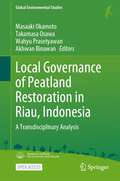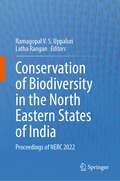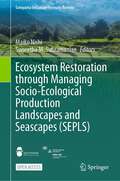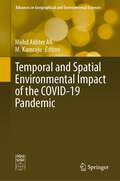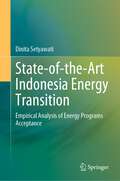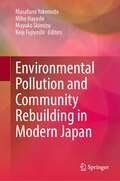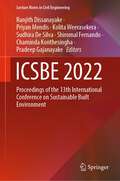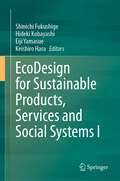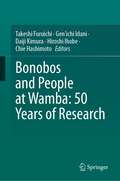- Table View
- List View
Redefining the Agenda for Social Justice: Voices from Europe and Asia
by Francine Mestrum Meena MenonThe book relates three years of history of social movements from Asia and Europe who work on social justice, as a rough overview. The work for the book is mainly done on the ground, day after day, working in villages and cities, with people and their organisations, organising resistance and preparing alternatives. It is based on the fact that European and Asian concerns are identical, in spite of divergent levels of development and wealth, and that the existing international initiatives, such as the ILO’s social protection floors, or the UN’s Sustainable Development Goals are perfectly compatible with neoliberal policies.The book goes beyond and sees social commons as a strategic tool for transforming societies. It is basically a project for the sustainability of life, of humans, of societies, and of nature. The book describes the ideas at the basis of the work in different sectors. It is not about the practice of social policies but about the ideas and discourses that can in the end shape the political practices. In sum, this book, presents a new social paradigm. It concretely shows how social justice and environmental justice do go hand in hand.
Towards the Local Government’s Integrated Accountability Framework: A Critical Lesson from Socio-Environmental Issues in Indonesia
by Habib Muhammad ShahibThis book shows the growing phenomenon and the broad impact of socio-environmental conflicts in the grassroots communities—farmers, fishermen and urban poor—in Indonesia, as the effects of government’s development strategies based on neoliberal and New Public Management (NPM) views without a clear accountability system or socio-environmental accountability practices and reports are becoming apparent. Inspired by the emancipatory socio-environmental accounting discourse, which focuses on the socio-local context in developing alternative models of accountability based on local views and people's aspirations, this book uses research methodology based on the principles put forth by Indonesian national hero and critical scholar Tan Malaka to develop a framework of integrated accountability for the local government. This book fills the present gap in English publications that analyse the intents and outcomes of the public management reforms in Indonesia with regard to socio-environmental issues, as a basis for further research at the international level as well as policymaking in Indonesia. As the Indonesian government has recently undertaken key structural and accounting reforms in the public sector, this book is a timely and valuable read for graduate students, researchers,- and policymakers.
Fostering Transformative Change for Sustainability in the Context of Socio-Ecological Production Landscapes and Seascapes (SEPLS)
by Maiko Nishi Suneetha M. Subramanian Himangana Gupta Madoka Yoshino Yasuo Takahashi Koji Miwa Tomoko TakedaThis open access book is a compilation of case studies that provide useful knowledge and lessons that derive from on-the-ground activities and contribute to policy recommendations, focusing on the relevance of social-ecological production landscapes and seascapes (SEPLS) to “transformative change.” The concept of “transformative change” has been gaining more attention to deal with today’s environmental and development problems, whereas both policy and scientific communities have been increasingly calling for transformative change toward sustainable society. The Intergovernmental Science-Policy Platform on Biodiversity and Ecosystem Services (IPBES) has planned to start the so-called “assessment on transformative change” if approved by the IPBES plenary to be held in 2021. At present, the idea of transformative change, including its scope, methodologies, approaches and strategies, are yet to be clarified. By bringing together all of the different concerns and interests in the land/seascape, SEPLS approaches could provide practical and experience-based insights for understanding and gauging transformative change and identifying determinants of such change. This book explores how SEPLS management relates to the idea of transformative change to further the discussion of sustainable transitions in advancing sustainability science. The introductory chapter is followed by case study chapters offering real-world examples of transformative change as well as a synthesis chapter clarifying the relevance of the case study findings to policy and academic discussions. It will be of interest to scholars, policymakers and professionals in the fields related to sustainable development.
Ecological Risk Management: For Conservation Biology and Ecotoxicology (Ecological Research Monographs)
by Hiroyuki MatsudaThis book introduces the theory and practice of ecological risk management. Using recent and live case studies in Japan, the book explains the use of basic mathematical techniques in extinction risk, adaptive population management, avian collision risk in wind farms, potential biological removal for marine mammals, and ecological risk assessment of heavy metals. The focus of this book is on case studies of nature conservation in Japan, including internationally renowned topics of Japanese fisheries, Shiretoko World Heritage, Fukushima Daiichi Nuclear Power Plant accident. It also covers the adaptive risk management of the new coronavirus disease.The book comprises four parts covering ecotoxicology, fisheries, wildlife management and conservation, and ecosystem-based management. It differs from other books in having its primary interest in human impacts on animals, plant, and ecosystems, while existing works in this area concentrate on the fate of toxic substances in the environments and their effects on humans. This book is unique in that it indicates various environmental issues that the theoretical ecology is potentially applicable without concentrating into any particular subject such as ecotoxicology or conservation biology. Primary readers are undergraduate/graduate students, staffs of environmental consultant companies and environmental NPOs, and journalists. Readers will find this book useful for its abundant information on case studies of ecological risk management and consensus building in Japan.
Governments’ Responses to Climate Change: Selected Examples From Asia Pacific (SpringerBriefs in Environment, Security, Development and Peace #10)
by Nur Azha Putra Eulalia HanThis multidisciplinary volume articulates the current and potential public policy discourse between energy security and climate change in the Asia-Pacific region, and the efforts taken to address global warming. This volume is unique as it analyses two important issues climate change and energy security through the lens of geopolitics at the intersection of energy security. It elaborates on the current and potential steps taken by state and non-state actors, as well as the policy innovations and diplomatic efforts (bilateral and multilateral, including regional) that states are pursuing. This Brief stems from the assumption that its audience is aware of the consequences of climate change, and will therefore, only look at the issues identified. It provides a useful read and reference for a wide-range of scholars, policymakers, researchers and post-graduate students.
From Sources to Solution: Proceedings of the International Conference on Environmental Forensics 2013
by A. Z. Aris T.H. Tengku Ismail R. Harun A. M. Abdullah M. Y. IshakFeaturing the theme, From Sources to Solution, this book is based on the research papers presented during the International Conference on Environmental Forensics 2013. It covers multi-disciplinary areas of environmental forensics featuring major themes: characterization, assessment, and monitoring; new approach, rapid assessment, and analytical techniques; pollution control technology; environmental health risk assessment; and policy, governance and management. It present information for researchers from the science and social sciences disciplines and contribute to the advancement of Environmental Forensics. It also aims at evaluating the environmental damages as the result of indiscriminating discharge of toxic environmental pollutants.
Embedding New Technologies into Society: A Regulatory, Ethical and Societal Perspective
by Diana M. Bowman Elen Stokes Arie RipThe embedding of any new technologies in society is challenging. The evolving state of the scientific art, often-unquantifiable risks and ill-defined developmental trajectories have the potential to hinder innovation and/or the commercial success of a technology. The are, however, a number of tools that can now be utilized by stakeholders to bridge the chasm that exists between the science and innovation dimensions on the one hand, and the societal dimensions on the other. This edited volume will draw together leading researchers from the domains of law, philosophy, political science, public administration and the natural sciences in order to demonstrate how tools such as, for example, constructive technology assessment, regulatory governance and societal scenarios, may be employed by stakeholders to assist in successfully embedding new technologies into society. This volume will focus primarily on the embedding of two emergent and emerging technologies: nanotechnologies and synthetic biology. Government, industry and the epistemic community continue to struggle with how best to balance the promised benefits of an emerging technology with concerns about its potential impacts. There is a growing body of literature that has examined these challenges from various cultural, scientific and jurisdictional dimensions. There is, however, much work that still needs to be done; this includes articulating the successes and failures of attempts to the societal embedding of technologies and their associated products. This edited volume is significant and timely, as unlike other books currently on the market, it shall draw from real work experiences and experiments designed anticipate the societal embedding of emerging technologies. This empirical work shall be supported by robust theoretical underpinnings.
Handbook of Materials Circular Economy
by Seeram Ramakrishna Brindha RamasubramanianThis book provides comprehensive and practical information on the design and implementation of circular systems for various industries, with a focus on Environmental, Social, and Governance (ESG) factors. The scope of the handbook is to cover the materials circularity in a deeper analysis in accordance to ESG used in various industries such as oil and gas, IT, electronics, medicine, textile, and more. The handbook also covers the key principles of the circular economy, including material efficiency, resource conservation, and waste reduction, and how they impact to different industries. It further critically analyses the challenges and opportunities associated with implementing circular systems in these industries, including the framework for new business models and technical innovations, and the potential benefits in terms of environmental protection, social responsibility, and economic competitiveness. In addition to providing practical information, the handbookalso addresses the ESG factors associated with the circular economy exclusively for each industry. This would include the impact of circular systems on the environment, including the reduction of greenhouse gas emissions and the protection of biodiversity, as well as the social benefits, such as job creation, and the economic benefits, such as cost savings and increased competitiveness. The ultimate goal of the handbook should be to provide guidance and support in a niche evaluation for the development of a more sustainable and equitable future, where the circular economy is a key enabler.
Microbial Applications for Environmental Sustainability
by Arun Karnwal Abdel Rahman Mohammad Said Al-TawahaThis book focuses on the various applications of microorganisms for sustainable environment and the reduction of hazardous pollutants released in various forms, including xenobiotics, e-waste, pesticides, insecticides, plastic, heavy metals, paper waste, medical waste, textile dyes, and their impact on environmental and human health. The book involves a series of research reports that explain the application of microbes used to solve real-life issues raised due to changes happening in environment, including pollution, by covering applications, including the use of bacteria, fungi, microalgae and biofilm in the detection and degradation of crude oil, pesticides, dyes, e-waste, heavy metals and other pollutants. It also focuses on integrative strategies in the application of microbial nanomaterials for remediation of pollutant. This material will help environmental scientists and microbiologists to learn about existing environmental problems and suggest novel ways to control or contain their effects by employing various treatment approaches.
Water Resources in the Lancang-Mekong River Basin: Impact of Climate Change and Human Interventions
by Qiuhong Tang Deliang Chen Junguo LiuThis open access book provides a comprehensive, up-to-date picture of the current state of knowledge covering climate change, surface water change, arsenic pollution, water utilization, water-food-energy nexus, water related hazards, water management, and water governance in the Lancang-Mekong River Basin. Considering the widely concerned fact that the climate change and human intervention induced impacts on water will bring unprecedented threats to human societies and ecosystems, the book intends to support UN’s sustainable development goals through sustainable use of water by providing the most accurate and updated information on climate and water changes in a consistent way. Underlying all aspects of the book is a strong commitment to assessing the science comprehensively, without bias and in a way that is relevant to policy but not policy prescriptive. It can provide implications to support decision-makers and stakeholders for integrated water resources management and sustainable development at all levels.
Climate Change Adaptation: Traditional Wisdom and Cross-Scale Understanding
by Nalini Bikkina Rama Mohana R. TuragaThis book discusses how climate change needs to be anchored in indigenous knowledge with reference to resource management, infrastructure, livelihoods, and social institutions, with a unique focus on risks and provenances of resilience available to the local communities. Beyond the scientific know-how on climate change, this volume highlights traditional wisdom, which through its hands-on learning plays a crucial role in amalgamation with cross-scale understanding. It documents the deliberations of a seminar that brought together traditional wisdom and cross-scale understanding of academicians, researchers, practitioners, and grassroots functionaries directly or indirectly working with communities in the area of climate change adaptation and thereby brings together adaptation and allied practices from across a spectrum of specialties and practitioner contexts. It discusses several insights and novel practices and is purported to provide significant research and policy implications in the spirit of thinking globally but acting locally.
Energy Transitions and Climate Change Issues in Asia
by Soocheol Lee Ken-Ichi Akao Budy Prasetyo Resosudarmo Shiqiu Zhang Jong Ho Hong Orapan Nabangchang-SrisawalakThe rapid pace of economic development and urbanization in Asia have led to several major problems such as greenhouse gas emissions, mass consumption, and depletion of natural resources. These problems pose a major threat to a sustainable future for Asia and are hindering many Asian countries' goal of becoming carbon-neutral by the middle of this century. Solving these problems requires a comprehensive understanding of the nature of energy consumption, exploitation of natural resources, and deterioration of the environment.To accelerate the green energy transition and promote efficient resource use in Asia, a range of policy options and joint efforts among Asian countries will be required, including carbon pricing, resource tax reform, the expansion of transition finance, support for the development of low-carbon, and resource-efficient social infrastructure. However, Asia is home to many countries, each in a different stage of economic development and with its own culture and customs. Practical implementation of these policies will require bringing together researchers, policymakers, and citizens to share their knowledge and engage in discussions to generate policy ideas that are appropriate for each country. The purpose of this book is to share theoretical and empirical knowledge and convey policy implications that can be expected to accelerate energy transition and resource use effectiveness toward a sustainable future in Asia.
Learning from Weather Modification Law for the Governance of Regional Solar Radiation Management
by Manon SimonThis book investigates the role of cloud seeding laws in governing regional solar radiation management (SRM) activities. It challenges the prevailing belief that cloud seeding laws are irrelevant to regional SRM governance and argues for their applicability. Through case studies in Australia, Canada, and the United States, the book highlights the need for legal frameworks that promote cross-scale interactions, stakeholder participation, flexible decision-making, and conflict resolution. It advocates for adopting adaptive governance principles to effectively manage the risks and uncertainties associated with regional SRM interventions. By filling a gap in the existing literature, this book offers valuable insights and recommendations for the governance of regional SRM, shedding light on the potential of cloud seeding laws to inform and shape SRM governance frameworks. It provides a comprehensive analysis of the legal and normative aspects, offering practical guidance for policymakers, researchers, and stakeholders involved in regional SRM initiatives.
Communicating Climate Change in China: A Dynamic Discourse Approach
by Sidan WangThis book explores how China's media narrate climate policy and climate change. With the rapid growth of economy and carbon emissions, China has been seen as having a key role in addressingclimate change and receives substantial attention from the media. In theChinese coverage, climate change issues can be interpreted as various concernsand ideas involving the dimensions of the economy, energy and emissions, publicinvolvement, science and ecology, and responsibility. In this sense, a discourseapproach can be used to understand how the newspapers construct the climatechange discourse and discourse networks in the coverage. This study selectsthree different newspapers in China, namely People’sDaily, China Daily and Southern Weekend. This book will interest scholars of Chinese politics, environmentalists, and media studies scholars.
Theories in Ecological Risk Assessment (Theoretical Biology)
by Masashi KamoThis book introduces various mathematical models used in ecological risk assessment, primarily discussing models used in hazard assessment. The book aims to link ecology and conservation biology with risk assessments, bringing together the knowledge of ecotoxicology and ecology for effective risk assessment. The first part describes population-level assessment in ecological risk assessment. The chapters cover current methodologies for ecological risk assessment, individual-level assessment, population dynamics models for population-level assessment, case studies, mathematical models for population extinctions, the derivation of mean time to extinction (MTE) and their case studies. The second part of the book discusses the mathematical models involved in hazard assessments. It introduces the method of risk assessment using species sensitivity distributions (SSDs), hazard assessment of metals, chemical mixtures using the Michaelis-Menten equation, basic elements of statistics and related topics. Expected readers are risk assessors in governments and public sectors, students and young researchers interested in environmental science. The book is made accessible and easy to follow by beginners in mathematical biology and theoretical ecology.
The Path to a Sustainable Civilisation: Technological, Socioeconomic and Political Change
by Mark Diesendorf Rod TaylorThe Path to a Sustainable Civilisation shows that we have unwittingly fallen into an existential crisis of our own making. We have allowed large corporations, the military and other vested interests to capture governments and influence public opinion excessively. We have created a god called ‘the market’ and allowed our most important decisions to be made by this imaginary entity, which is in fact a human system controlled by vested interests. The result has been the exploitation of our life support system, our planet, and most of its inhabitants, to the point of collapse. This book argues that the way out of our black hole is to build social movements to apply overwhelming pressure on government and big business, weaken the power of vested interests and strengthen democratic decision-making. This must be done simultaneously with action on the specific issues of climate, energy, natural resources and social justice, in order to transition to a truly sustainable civilisation.
Local Governance of Peatland Restoration in Riau, Indonesia: A Transdisciplinary Analysis (Global Environmental Studies)
by Masaaki Okamoto Takamasa Osawa Wahyu Prasetyawan Akhwan BinawanThis open access book is one in a series of four volumes introducing peatland conservation and restoration in Indonesia. It focuses on local governance, in particular on regional and local perspectives in Riau, the most peat-destructed province of Indonesia. The book fills a vital gap in the existing literature that overlooks social science and humanities perspectives. Written by authors from different disciplines and backgrounds (including scholars and NGO activists), the approaches to the topic are various and unique, including analysis of GPS logs, social media, geospatial assessments, online interviews (conducted due to the Covid-19 pandemic), and more conventional questionnaires and surveys of community members. The chapters cover an interdisciplinary understanding of peatland destruction and broadly offer insights into environmental governance. While presenting combined studies of established fieldwork methodologies and contemporary technology such as drones and geospatial information, the book also explores the potential of long-distance research with rural communities through online facilitation, which was brought about by Covid-19, but that may have longterm implications. Readers will gain a comprehensive understanding of the complexities surrounding peatland conservation and restoration and recognize the significance of locally inclusive approaches that use contemporary but accessible technologies to sustainably govern the globally important resource of peatland. That approach would be useful for other environmentally fragile but important regions and give some ideas to achieve the United Nations’ SDGs for 1)No Poverty, 5)Gender Equality, 13)Climate Action, 15)Life of Land.
Conservation of Biodiversity in the North Eastern States of India: Proceedings of NERC 2022
by Ramagopal V. S. Uppaluri Latha RanganThis volume presents part of the proceedings of NERC 2022, with an emphasis on conservation of bio-diversity in North-east India. This is a highly challenging and involved topic due to regionally diverse physiographic, geographical and eco-climatic conditions. Henceforth, systemic and holistic frameworks are required to disseminate upon the potential of science and technology for the conservation of the region’s bio-diversity. Notable among these frameworks refers to plant, microbial and animal bio-diversity conservation, value-added product development and sharing the benefits of such research for the perspective of bio-prospects, analysing critical environmental and climatic factors and their sensitivity upon urbanization strategies. Tools that are to be deployed for such insights involve plant, animal, and microbial bioscience and biotechnology, generalized rules for product design and development and survey based strategies. Addressing relevant competent methodologies and generic pedagogies, this volume on the bio-diversity conservation in North-eastern states of India aims to demonstrate the potential of pragmatic strategies that can be applied for the bio-diversity conservation in any region of world. Thereby, opportunities for nature linked livelihood security can be sought for the long term wellbeing of the humankind and ecology.
Ecosystem Restoration through Managing Socio-Ecological Production Landscapes and Seascapes (Satoyama Initiative Thematic Review)
by Maiko Nishi Suneetha M. SubramanianThis open access book is a compilation of case studies that provide useful knowledge and lessons that derive from on-the-ground activities and contribute to policy recommendations, focusing on the relevance of social-ecological production landscapes and seascapes (SEPLS) to ecosystem restoration. Building on the concept of SEPLS, the Satoyama Initiative promotes landscape approaches as integrative area-based strategies to bring together diverse stakeholders aiming to balance multiple objectives, including conservation and development, for the benefit of biodiversity and human well-being. Many of the SEPLS case studies from the International Partnership for the Satoyama Initiative (IPSI) offer rich evidence to help guide restoration efforts while advancing relevant knowledge and practices. The book highlights how the efforts in managing SEPLS can contribute to ecosystem restoration and sustainable development, looking at the strategies and approaches by which multiple stakeholders express, negotiate, and embrace their plural value perspectives of nature to restore ecosystems within a landscape or seascape. It begins with an introductory chapter followed by twelve case studies and a synthesis clarifying the relevance of the case study findings to policy and academic discussions. This book will be of interest to scholars, policymakers and professionals in the field related to sustainable development, especially on SDGs 15 and 17.
Temporal and Spatial Environmental Impact of the COVID-19 Pandemic (Advances in Geographical and Environmental Sciences)
by Mohd Akhter Ali M. KamrajuThis book identifies, evaluates and reports the impacts of the COVID-19 pandemic on the physical, biological and socioeconomic environment, using the science and technology of geoinformatics. It encourages the environmental considerations in the future city and policy planning and decision-making. For example, according to the World Health Organization, 80% of people living in cities are exposed to polluted air that exceeds healthy levels. City planners have applied the developing concepts of sustainability to modern debates over how cities and regions should be reviewed, regenerated and reformed since the introduction of the concept in developmental science. During the COVID-19 pandemic, a remarkable drop in air pollution has been observed in India and other countries, which has accelerated the shift to green and sustainable development. Geoinformatics can provide solutions and resources for local, sustainable activities in education, health, sustainable agriculture, resource management and related fields. This book serves researchers in a variety of areas, including hazards, land surveys, remote sensing, cartography, geophysics, geology, natural resources, environment and geography.
State-of-the-Art Indonesia Energy Transition: Empirical Analysis of Energy Programs Acceptance
by Dinita SetyawatiThis book discusses how people can come together to address current energy justice and access poverty problems by examining the relationship between energy systems and society in diverse energy sources. The novelty of this book is that this is the only complete guide for readers who wish to understand the status of Indonesia’s energy transition and renewable energy development. Energy programs that are explored are the ones prioritized by government administrations, including coal, nuclear power, solar energy, green electricity, and geothermal energy. Based on extensive fieldwork and empirical data, the book combines insights from historical data on energy subsidies and economic diversification, current empirical data on social acceptance of new energy technologies, and contemporary studies that forecast the implications of the transition to the coal industry and fossil fuel subsidies. It asks how Indonesia has enacted policies that support energy transition. How do the public and civil society view those policies? What are the implications for broader themes and discussions on energy sources, technology, systems, policies, and service? Strategies are suggested to advance a sustainable transition in the developing world that will mitigate developmental risks associated with the transition away from fossil fuels while encouraging decision making in a sustainable and socially just manner. This book is an informative and engaging read for a general audience as well as a valuable resource for scholars, researchers, and students in environmental and energy studies.
Environmental Pollution and Community Rebuilding in Modern Japan
by Masafumi Yokemoto Miho Hayashi Mayuko Shimizu Keiji FujiyoshiThis book describes how modern industry affected people in Japan and their communities by polluting their living environment with toxic emissions. It also shows how the populace endeavored not only to restore their once-clean environment but also to rebuild communities that had been damaged by pollution and its accompanying effects. Environmental pollution is usually referred to in Japan as kogai, public damage, meaning that such pollution not only harms the physical environment—air, water, soil, and the human body—but also destroys the social and personal relationships in the polluted area. Those people who took action recognized that industrial and economic development had been given the highest national priority even at the cost of their health and welfare. In this sense, anti-kogai movements led them to alternative community development and to rethinking what kind of environment and community they wanted. This book also explores the efforts driven by residents in several parts of Japan after the middle of the twentieth century and the endeavors of museums and archives as a memorial to those who suffered from the pollution and for the prospect of a better society with a good environment.
ICSBE 2022: Proceedings of the 13th International Conference on Sustainable Built Environment (Lecture Notes in Civil Engineering #362)
by Ranjith Dissanayake Priyan Mendis Kolita Weerasekera Sudhira De Silva Shiromal Fernando Chaminda Konthesingha Pradeep GajanayakeThis book highlights the latest knowledge and innovations in the fields of civil engineering and construction industry striving for a sustainable built environment. It consists of high quality and innovative research findings selected from the proceedings of the 13th ICSBE 2022 under the themes of sustainable construction, urban green infrastructure and planning, rainwater harvesting and water conservation, high-performance concrete, indoor environmental quality and indoor plants, wind and hydro-power energy, waste and wastewater management for enhanced sustainability, impacts of climate change, carbon footprint, global climate model and landscaping, material flows and industrial ecology, sustainable materials, etc.
EcoDesign for Sustainable Products, Services and Social Systems I
by Shinichi Fukushige Hideki Kobayashi Eiji Yamasue Keishiro HaraThis 2-volume book highlights cutting-edge ecodesign research and covers broad areas ranging from individual product and service design to social system design. It includes business and policy design, circular production, life cycle design and management, digitalization for sustainable manufacturing, user behavior and health, ecodesign of social infrastructure, sustainability education, sustainability indicators, and energy system design. Featuring selected papers presented at EcoDesign 2021: 12th International Symposium on Environmentally Conscious Design and Inverse Manufacturing, it also includes diverse, interdisciplinary approaches to foster ecodesign research and activities. In the context of Sustainable Development Goals (SDGs), in particular SDG 12 (Responsible Consumption and Production), it addresses design innovations for sustainable value creation, considering technological developments, legislation, and consumer lifestyles. Further, the book discusses the concept of circular economy, which aims to develop circular business models for resource efficient society by taking advantage of digital technologies including artificial intelligence, internet of things, digital twin, data analysis and simulation. Written by experts from academia and industry, Volume 1 highlights sustainable design such as product and process design, collaborative design, sustainable innovation, digital technologies, design methodology for sustainability, and energy system design. The methods, tools, and practices described are useful for readers to facilitate value creation for sustainability.
Bonobos and People at Wamba: 50 Years of Research
by Takeshi Furuichi Gen'Ichi Idani Daiji Kimura Hiroshi Ihobe Chie HashimotoThis book reviews all the findings about bonobos and the local people of Wamba village in the Luo Scientific Reserve in the Democratic Republic of the Congo over the last 50 years. In 1973, Takayoshi Kano, a Japanese primatologist, traveled across a vast area of the Congo Basin with a bicycle and found Wamba village to be a promising site to start his first studies on wild bonobos. Since then, many researchers from Japan and all over the world have been working at Wamba, now the longest standing study site, to uncover various aspects of the ecology and behavior of this most recently identified great ape species. The researchers study bonobo behaviors and carry out various activities for the conservation of bonobos. They also conduct anthropological studies of local people who live with bonobos and believe them to be distant relatives from the same family, living in the forest. This book is published in commemoration of 2023 marking the 50th year of study. The main chapters are contributed by active researchers studying bonobos and the local people at Wamba. The book also includes contributions from various eminent researchers who have carried out short-term research or have supported research at Wamba, which helps place these studies of bonobos in a broader primatological or anthropological perspective. This book will be a useful resource for professional researchers in primatology and anthropology, as well as graduate or undergraduate students interested in these research fields.
